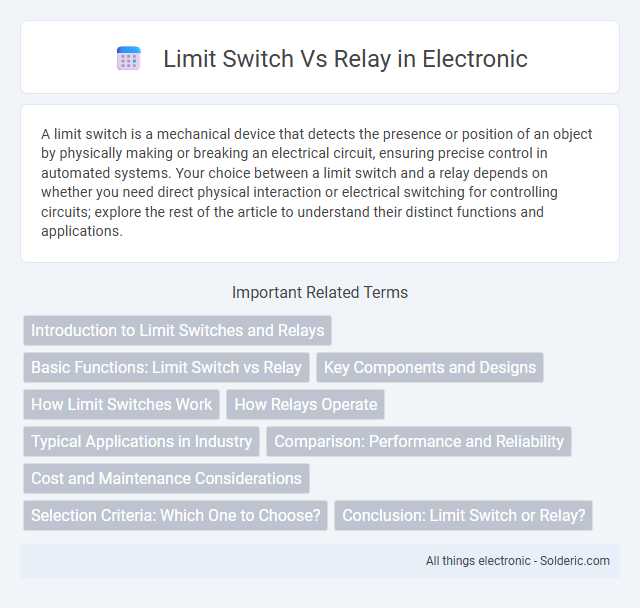A limit switch is a mechanical device that detects the presence or position of an object by physically making or breaking an electrical circuit, ensuring precise control in automated systems. Your choice between a limit switch and a relay depends on whether you need direct physical interaction or electrical switching for controlling circuits; explore the rest of the article to understand their distinct functions and applications.
Comparison Table
| Feature | Limit Switch | Relay |
|---|---|---|
| Function | Detects mechanical position or movement. | Electromagnetically switches electrical circuits. |
| Operation | Mechanical actuation by physical contact. | Electrical control with coil energization. |
| Usage | Position sensing and safety interlocks. | Circuit switching and control automation. |
| Contact Type | Normally Open (NO) or Normally Closed (NC). | Multiple contacts - NO and NC configurations. |
| Response Time | Mechanical delay, slower. | Fast electrical switching. |
| Durability | Subject to mechanical wear. | Longer lifecycle with less mechanical stress. |
| Applications | Limit detection in machinery, conveyor systems. | Control panels, automation systems, motor starters. |
Introduction to Limit Switches and Relays
Limit switches are electromechanical devices designed to detect the presence or position of an object by making or breaking an electrical connection when triggered. Relays function as electrically operated switches that use an electromagnet to mechanically operate a set of contacts, enabling control of high-power circuits with low-power signals. Both components are essential in automation systems, where limit switches provide precise positional feedback and relays facilitate circuit control and isolation.
Basic Functions: Limit Switch vs Relay
Limit switches serve as electromechanical devices that detect the presence or position of an object by physically interacting with it, triggering control actions in machinery. Relays, on the other hand, function as electrically operated switches that open or close circuits based on input signals, enabling control of high-power devices using low-power signals. Understanding the basic functions of a limit switch versus a relay helps you select the appropriate component for precise control or power switching applications.
Key Components and Designs
Limit switches feature mechanical actuators such as levers, plunger, or roller arms that physically detect object presence or position through direct contact. Relays consist of an electromagnetic coil and a set of electrical contacts, enabling electrical isolation and control of high-power circuits via low-power signals. The design of limit switches emphasizes durability and precise mechanical actuation, while relay designs focus on electrical switching capabilities and coil-induced magnetic operation.
How Limit Switches Work
Limit switches operate by detecting the physical presence or position of an object through mechanical movement, triggering an electrical contact to open or close a circuit. These electromechanical devices use actuators such as levers or plungers that respond to motion, providing precise control in automation systems. Unlike relays that function as electrically operated switches, limit switches directly sense mechanical changes, ensuring reliable position detection for machinery safety and control.
How Relays Operate
Relays operate by using an electromagnet to mechanically switch electrical contacts, allowing a low-power signal to control a higher-power circuit safely and efficiently. When current flows through the relay coil, it generates a magnetic field that moves the armature, thereby opening or closing the connected contacts. Understanding how relays operate helps you design systems that require reliable electrical isolation and switching control.
Typical Applications in Industry
Limit switches are commonly used in industrial automation for position sensing, safety interlocks, and machinery control, ensuring precise detection of moving parts in conveyors and robotic systems. Relays are essential for controlling high-power circuits, enabling automated switching of motors, lighting, and HVAC systems by using low-power control signals. Your choice depends on whether you need mechanical position detection with limit switches or electrical circuit control with relays in industrial applications.
Comparison: Performance and Reliability
Limit switches offer superior mechanical durability with precise position detection, making them highly reliable in harsh environmental conditions. Relays provide faster response times and greater versatility in electrical load switching but may experience contact wear over time, affecting long-term reliability. In performance-critical automation systems, limit switches excel in consistent operation, while relays are preferred for complex control circuit integration.
Cost and Maintenance Considerations
Limit switches generally have lower upfront costs compared to relays, making them a budget-friendly option for simple control applications. Their mechanical components may require periodic maintenance to ensure reliable operation, potentially increasing long-term maintenance efforts. You should factor in relay systems may incur higher initial investment, but often benefit from reduced mechanical wear and lower maintenance frequency over time.
Selection Criteria: Which One to Choose?
Limit switches are preferred for precise position detection, mechanical durability, and direct control of electrical circuits in industrial automation. Relays excel in switching higher power loads, providing electrical isolation, and enabling remote control in diverse applications. Selecting between a limit switch and a relay depends on factors such as application requirements, load capacity, response time, and environmental conditions.
Conclusion: Limit Switch or Relay?
Choosing between a limit switch and a relay depends on your specific control requirements and application environment. Limit switches provide direct mechanical feedback for position detection and are ideal for safety and automation systems requiring precise physical actuation. Relays offer versatile electrical control and isolation capabilities, making them suitable for switching multiple circuits and handling higher power loads.
Limit switch vs relay Infographic

 solderic.com
solderic.com